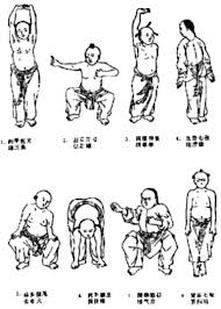Continuing the discussion on qi (also spelled chi), the natural potential energy present within the body, today I would like to discuss the topic and practice of taichi. Many of us associate taichi with that timeless cliche where old people move slowly in unison at the local park. Still, many are unaware that in its original form taichi was meant to be practiced as a martial art. As an internal martial art, it serves as an active meditation whereby one controls the flow of Qi within their own body, but what does this mean exactly?

As an internal martial art, taichi and qigong serve as active meditation whereby one controls the flow of qi within their own body, but what does this mean exactly? First, it is important to note that qi literally translates into “breath” or “air” and any practitioner will tell you the same thing in order to master one’s qi you must learn breath control. By creating tension through stretches and coupling these movements with controlled breathing one can improve blood flow, more efficiently and easily oxygenating muscles in areas that may have fallen into neglect.
The challenge lies in memorizing the movements, finding the time to learn proper breathing, or even finding time to complete all the movements in order before your schedule demands you elsewhere. This is probably why taichi is so often associated with the elderly and retired strata in society and it is also why I recommend beginning with one of the most simplistic forms of Chinese qigong or internal kung-fu: Baduanjin.
Baduanjin, also known as the Eight Pieces of Brocade, traces its origins back to Henan Province an d the Shaolin Temple. It is believed to have been practiced by peasants as a means of defense when preparing for the spontaneity of a wild animal attack and was later adopted by the Shaolin Temple, a mecca for kung-fu, incorporating it into the essentials of their training. Today the forms are practiced by most as a form of calisthenics and can be done either standing up or sitting down. Personally, I move through the Eight-Section Brocade to wake up, improve my energy levels, and reduce stress and any added health benefits I view as icing on the cake. As with any sort of stretching exercise, daily practice will promote the healthy release of endorphins and a general improvement in one’s physical wellbeing.
d the Shaolin Temple. It is believed to have been practiced by peasants as a means of defense when preparing for the spontaneity of a wild animal attack and was later adopted by the Shaolin Temple, a mecca for kung-fu, incorporating it into the essentials of their training. Today the forms are practiced by most as a form of calisthenics and can be done either standing up or sitting down. Personally, I move through the Eight-Section Brocade to wake up, improve my energy levels, and reduce stress and any added health benefits I view as icing on the cake. As with any sort of stretching exercise, daily practice will promote the healthy release of endorphins and a general improvement in one’s physical wellbeing.
While Baduanjin is easy to learn and perfect for at home practice it’s important to remember that it is also a spiritual exercise and is part of a larger spiritual tradition, to truly reap the benefits qigong can offer it is always best to seek face to face instruction.
For those more interested in the health benefits gained through laymen’s practice this video, though no substitute for actual instruction is a great way to learn the movements and familiarize yourself with the breathing patterns. Above all remember to stay healthy and do what feel good for your body.